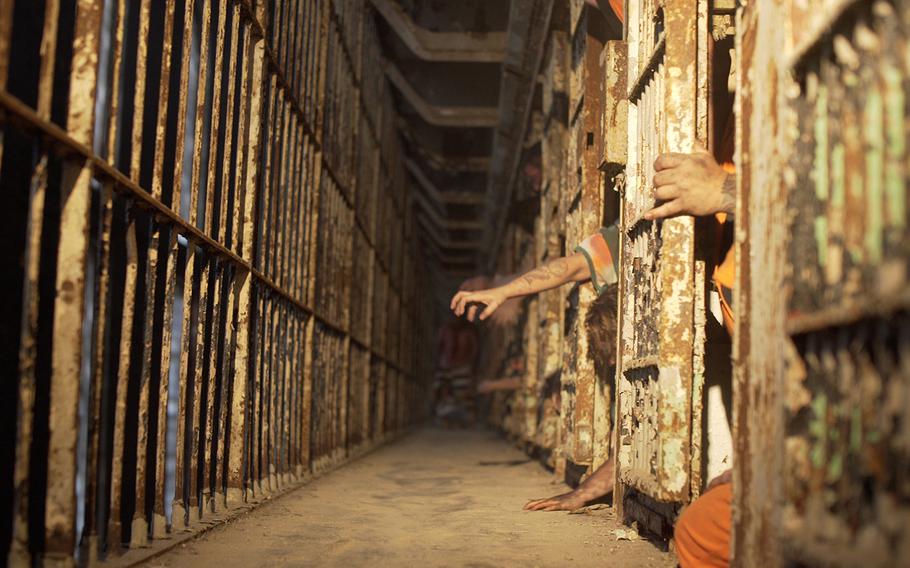
The Ohio State Reformatory in Mansfield is transformed into Blood Prison during October. (Weirick Communications/TNS)
For more than 2,000 years, people have believed that late in each October, the veil between the living and the dead becomes more fragile, allowing passage between the two worlds.
Mediums — those who claim to be in contact with those on the other side — have plenty of history in their favor.
Samhain — when the dead returned to earth — was observed by the ancient Celts and others living in what now is Ireland, France and England and by their Druid priests, who built bonfires and wore animal heads to ward off evil. In the 400 years that the Romans occupied the Celtic lands, their autumn festivals merged with Samhain and a time resembling Halloween emerged.
Paranormal activity has been studied by many firm believers of hauntings, and Ohio’s Mansfield area leads in ghostly experiences. They’ve been chronicled by Travel Channel’s “Ghost Hunters,” Discovery Channel’s “Ghost Stalkers” and “Ghost Adventures” along with shows on Netflix, History Channel, Hulu and National Geographic.
That’s especially true of the old Ohio State Reformatory, also known as the Mansfield Reformatory, which housed prisoners for nearly 100 years. This Halloween season it is home to the “Escape from Blood Prison” tour.
The 90-minute “Blood Prison” experience, which continues until Nov. 17, and the 90-minute after-dark tours frequently sell out.
According to publicists tasked with warning the timid, only the daring descend into the suffocating blackness of The Hole accompanied by the ear-splitting wail of the Warden’s Widow. Maniacal inmates and deformed guards fill the twisting turns of the world’s largest free-standing steel cell block. The Haunted Hospital, Blood Prison Chapel and Apocalyptic area were updated for this year with more Hollywood-like special effects.
Pay extra, if you dare, to give your permission to be touched by the scare actors.

Pay extra during the 90-minute “Escape From Blood Prison” tour to allow yourself to be touched by scare actors, such as these prisoners reaching out from their cells. (Weirick Communications/TNS)
The Gothic, castlelike prison was designed in 1896 by architect Levi Scofield, who also designed the Soldiers’ & Sailors’ Monument on Cleveland’s Public Square.
In the 94 years it was open, more than 200 people died at the Reformatory, including two guards killed during prison-escape efforts. Their stories — and their supposed prison hauntings since they died — have been incorporated into the tours. The horror is intense enough that many tours are limited to adults only.
The self-guided tour using an audio wand or digital audio guide is the only one considered family-friendly and open to children. Kids must be carefully supervised at all times because many areas of the prison are not safe for those under 42 inches tall. Strollers and wagons are not allowed.
The Reformatory was ordered closed by federal order in 1984 after prisoners brought a lawsuit against the state citing overcrowding and inhumane conditions. The closing was delayed until 1990, when a new prison, west of the Reformatory, was built and opened. In that time, tiny cells built to house two people often contained three prisoners.
The prison was used as the Shawshank State Prison location for the 1994 thriller “The Shawshank Redemption,” starring Morgan Freeman and Tim Robbins and widely considered one of the best films ever made.
One of the most popular options is the four-and-a-half-hour Shawshank Bus Tour, which includes a 90-minute “Hollywood Meets History” walking tour to explore “Shawshank” sites and those used in other films. The tour includes the West Attic, stories of inmate punishment, the sub-basement, the “Jesus Room,” the guard tower if weather permits, and the inner workings of The Ohio State Reformatory.
Given on select weekends through fall, it’s limited to visitors 13 and older. Public ghost hunts, available only to those 18 and older, give visitors the opportunity to accompany paranormal investigators.
Learn about the development of the electric chair and see the actual chair itself on select dates when ”Old Sparky: Electric Chair History and Ohio Executions” is given. That 90-minute session, beginning with a sit-down PowerPoint presentation, is followed by a guided walking tour to see Ohio’s electric chair.

A scary clown peers out of a rusted cell door during the “Escape From Blood Prison” tour at The Ohio State Reformatory in Mansfield. (Weirick Communications/TNS)
If you go
“Escape from Blood Prison” takes place from 7 p.m. to midnight each Friday and Saturday and 7 to 10 p.m. Sundays through Oct. 29. It frequently sells out, so advance online tickets are required and can be booked at BloodPrison.com, including $35 General Pass Timed Ticketing or Ultra Lightning Pass, which reduces wait time. A Touch Pass adds intensity, allowing scare actors to touch attendees. Gates open at 6:45 p.m., and food trucks are on site.
New this year, “Beyond the Scare” tours are being offered in daylight, letting visitors see behind the scenes of Blood Prison with the lights on. Those tickets are available between 11 a.m. and 4 p.m. daily at MRPS.org.
Detailed information for visiting the Mansfield Reformatory is at mrps.org.
Ask questions about paranormal investigations by email to Kathy Feketik at kathy@mrps.org.
“Escape From Blood Prison” is not appropriate for anyone under age 10, and preteens may find it too frightening.